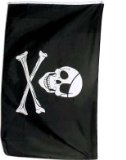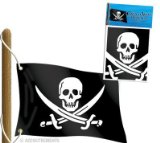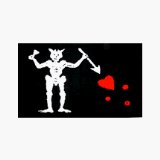More Pirate Pages
Pirate Fun
Pirate Flag, Pirate Flags, Jolly Roger Pirate Flag, Pirates Flag
All About The Jolly Roger
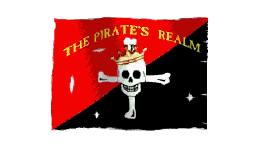
Most pirates wanted to avoid bloody close-contact fighting when possible, so using pirate flags was an excellent way to wage war from a distance on the minds and emotions, weakening resistance and forcing a quicker surrender. Read on learn about the jolly roger pirate flag and the symbols in the pirate flag pictures.
New! Pirate Flag Pictures In this article: Jolly Roger's origins / pirate's other flags / pirate symbols
Dem' Bones - The Origin of the ‘Jolly Roger’:
Some say the Jolly Roger pirate flag got its name from an all red flag used by early pirates to show that no mercy (or 'quarter' in period language) would be offered to the captured crew or passengers. This pirate flag was called "Jolie Rouge" in French, meaning 'pretty or beautiful red', certainly a tongue-in-cheek reference of buccaneers and the like. Another plausible explanation is that the term was the nickname given to the devil by pirates in the 1700's of "Old Roger." From its early references, the term Jolly Roger grew to be associated with all of the various pirate flags of the Golden Age of piracy.
Whatever the origin of the term, the facts about this pirate flag in modern usage are less colorful. Emmanuel Wynne is usually credited with flying the first Jolly Roger pirate flag around the year 1700 with his skull and crossbones on a black field, with an hourglass image under the skull.
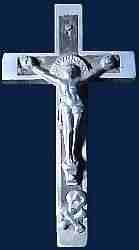 The skull and crossbones symbol so common on pirate flags might have been inspired from a tombstone symbol, but another possible origin comes from the crucifix, which in this time almost always included a skull and crossed bones under the cross of Jesus. These were
The skull and crossbones symbol so common on pirate flags might have been inspired from a tombstone symbol, but another possible origin comes from the crucifix, which in this time almost always included a skull and crossed bones under the cross of Jesus. These were symbolic of the death which He triumphed over, but they also referred to the outcropping of the crucifixion site, called Golgotha in Greek, meaning 'the skull'. This addition to the crucifix fell out of favor in the 1800's amid the growing reputation of pirates and their violence. Another documented place for the skull image was the ship's log. Any crew member who died during the voyage had it placed next to their name.
symbolic of the death which He triumphed over, but they also referred to the outcropping of the crucifixion site, called Golgotha in Greek, meaning 'the skull'. This addition to the crucifix fell out of favor in the 1800's amid the growing reputation of pirates and their violence. Another documented place for the skull image was the ship's log. Any crew member who died during the voyage had it placed next to their name.
The interpretations in popular culture and Hollywood swashbucklers make it hard to find the truth about the most popular of pirate symbols. The main thing to remember is that this iconic pirate flag in all its variety was only in use for around 20 years during the height of the Golden Age of piracy.
Other types of Pirate Flags:
National Flags - Since medieval times, it was common practice to fly your national flag. Some pirates had no personal pirate flag, but only flew the one of their homeland, as the Caribbean Buccaneers were known to do. 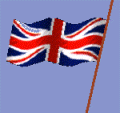 When a pirate received a letter of marque or privateering commission, they would fly the flag of the country which granted the commission. A variation of this practice was to give the appearance of attacking under a nation's authority by flying their flag.
When a pirate received a letter of marque or privateering commission, they would fly the flag of the country which granted the commission. A variation of this practice was to give the appearance of attacking under a nation's authority by flying their flag.
Another common ruse de guerre, or strategy of war for pirates was to fly the same flag as the target ship, which would often allow them to get closer. If this ruse was successful, the pirates would then run up their Jolly Roger to demand surrender or some colored flag if a chase ensued.
Solid color flags- were used before the skull and crossbones pirate flag existed. Some accounts report that pirates sometimes flew them while in pursuit, and others flew them in complement with other types while attacking. Regardless, the victims were never confused about what a certain color meant.
- Black has been emblematic of death from ancient times. A solid black flag was likely the first demand for surrender. In most situations, it was raised when an engagement was near - death was more certain for those who fought back.
White- This was the flag commonly used by pirates while in pursuit. Surrender was the meaning, "You must surrender," was the statement it made.
Red- This flag of blood said, "We will not give quarter." No quarter meant there would be no mercy, either because of the pirate's violent rage or the victim's evasiveness. A red flag could actually cause more resistance, because the victims' belief in certain death meant they had little to lose by fighting until the horrible conclusion.
Flag Symbols:
To drive home the message (and to express their inner artist), pirates started adding morbid symbols from what they had seen in the graveyards. Emmanuel Wynne is considered the innovator with his skull and cross bones over an hourglass. This meant the time to surrender was running out. Although most pirates wanted to avoid death, they were compelled to project an attitude of apathy or fearlessness with symbols such as a raised glass to toast death or a captain raising a glass in toast with a skeleton.
Other examples of the death obsession on pirate flags were:
- a pierced heart to speak of a merciless death...
- a heart with drops of blood, meaning a drawn-out and very painful death...
- a dart or spear symbolizing a violent death...
- a skeleton, showing a tormented death...
- and a cutlass in a hand or an empty fist, which let the poor saps know that any of these forms of death were available free of charge and without delay.
You could even try to use them all, like Blackbeard, who really seemed to enjoy all this fearful reputation stuff. His pirate flag showed a muscular skeleton with horns holding an hourglass in one hand and spear in the other that is pointing to a heart letting out three drops of blood.
(Blackbeard later wrote in his journal that some had suggested the skeleton should have scary tattoos, a black leather jacket, and a Harley to ride, but he felt that was overkill.)
Read about other Pirate Weapons
